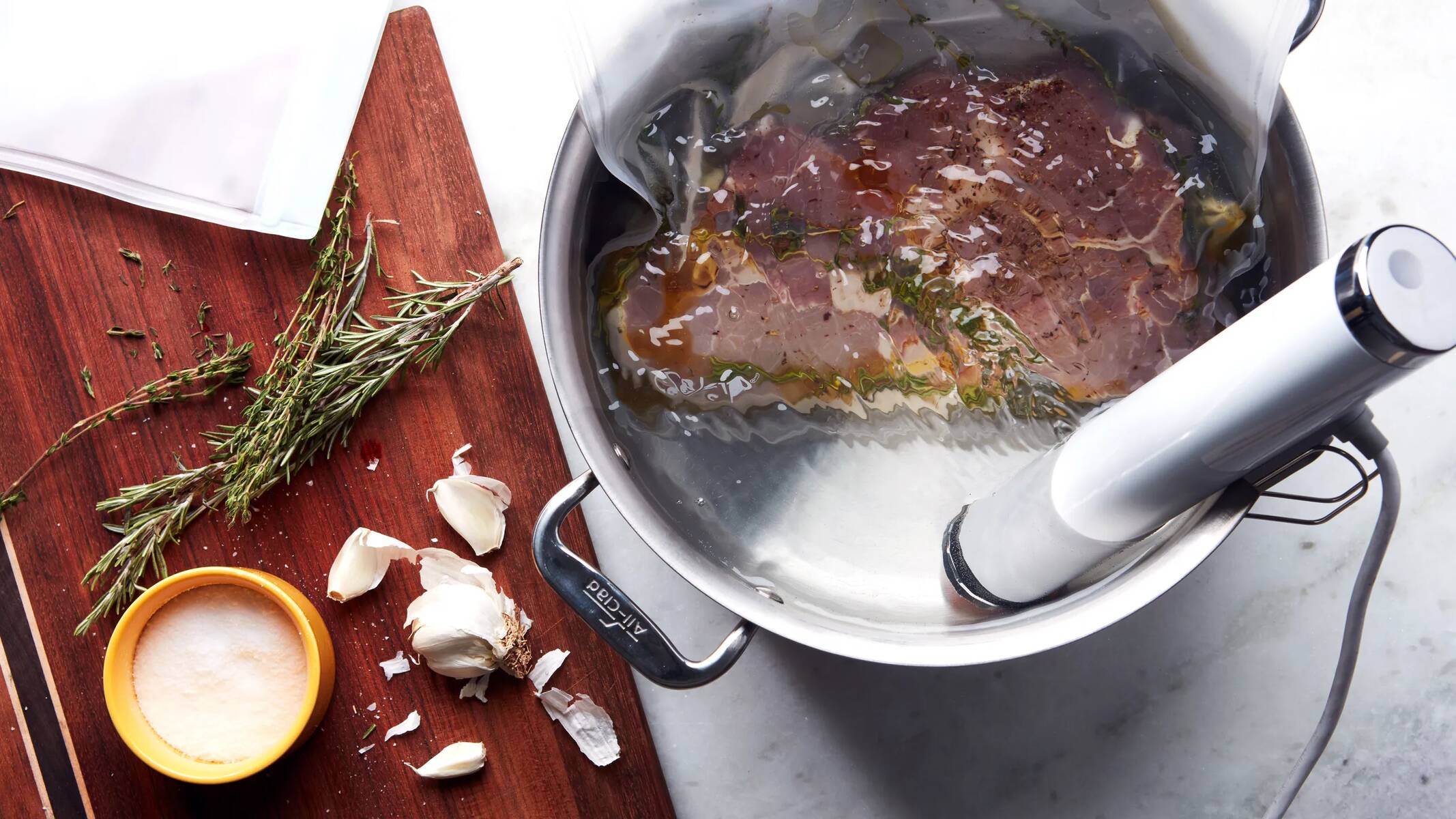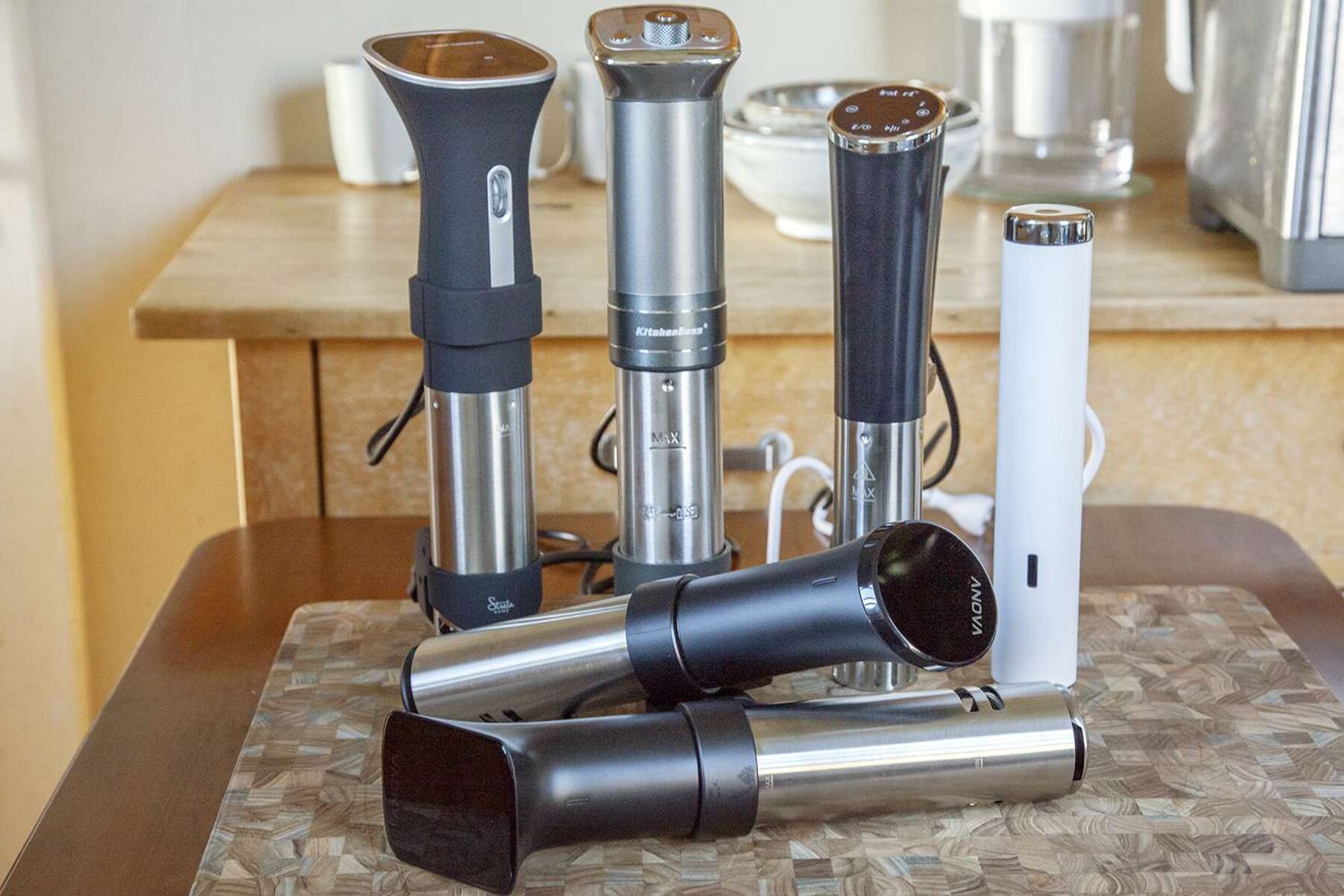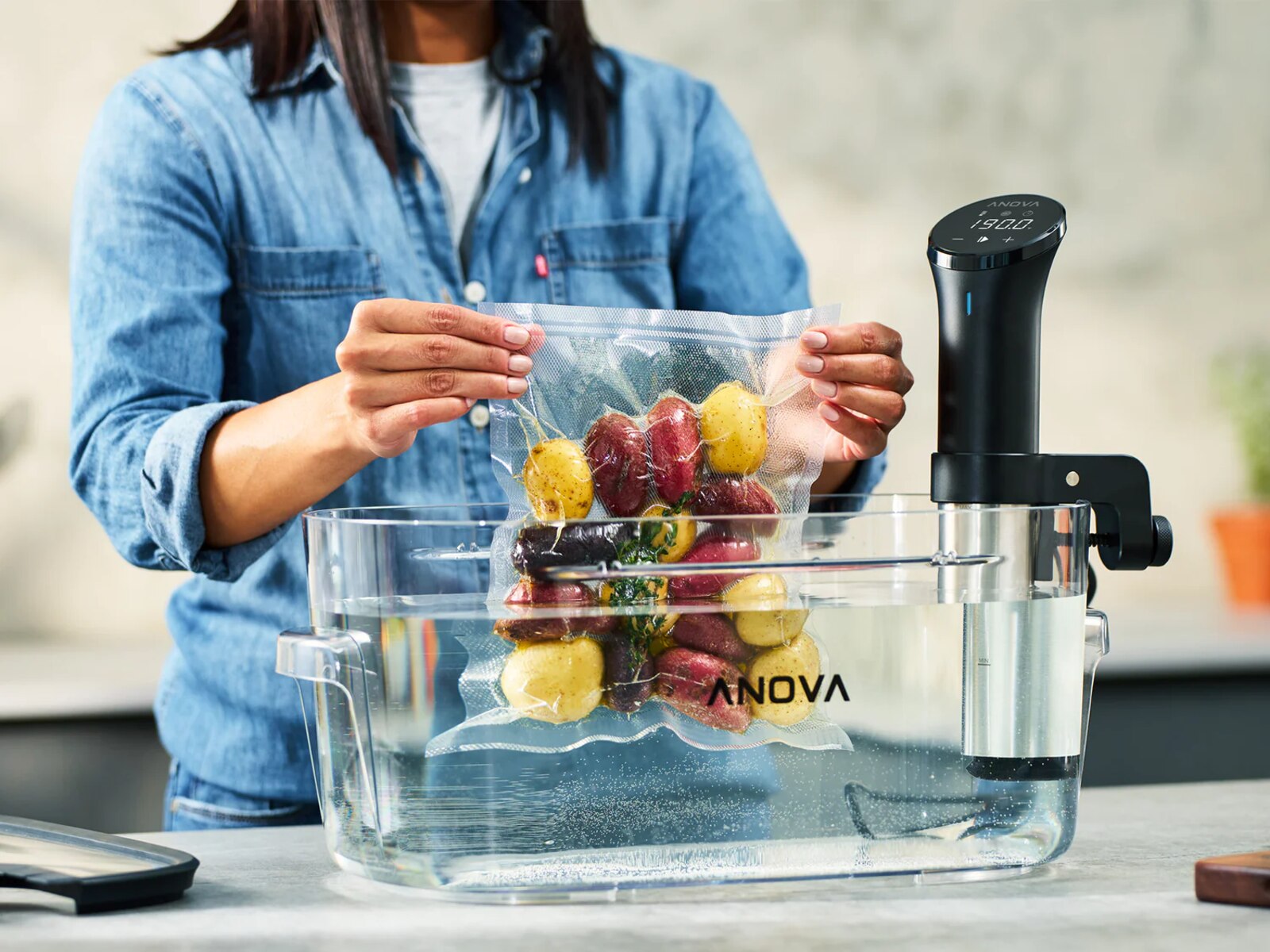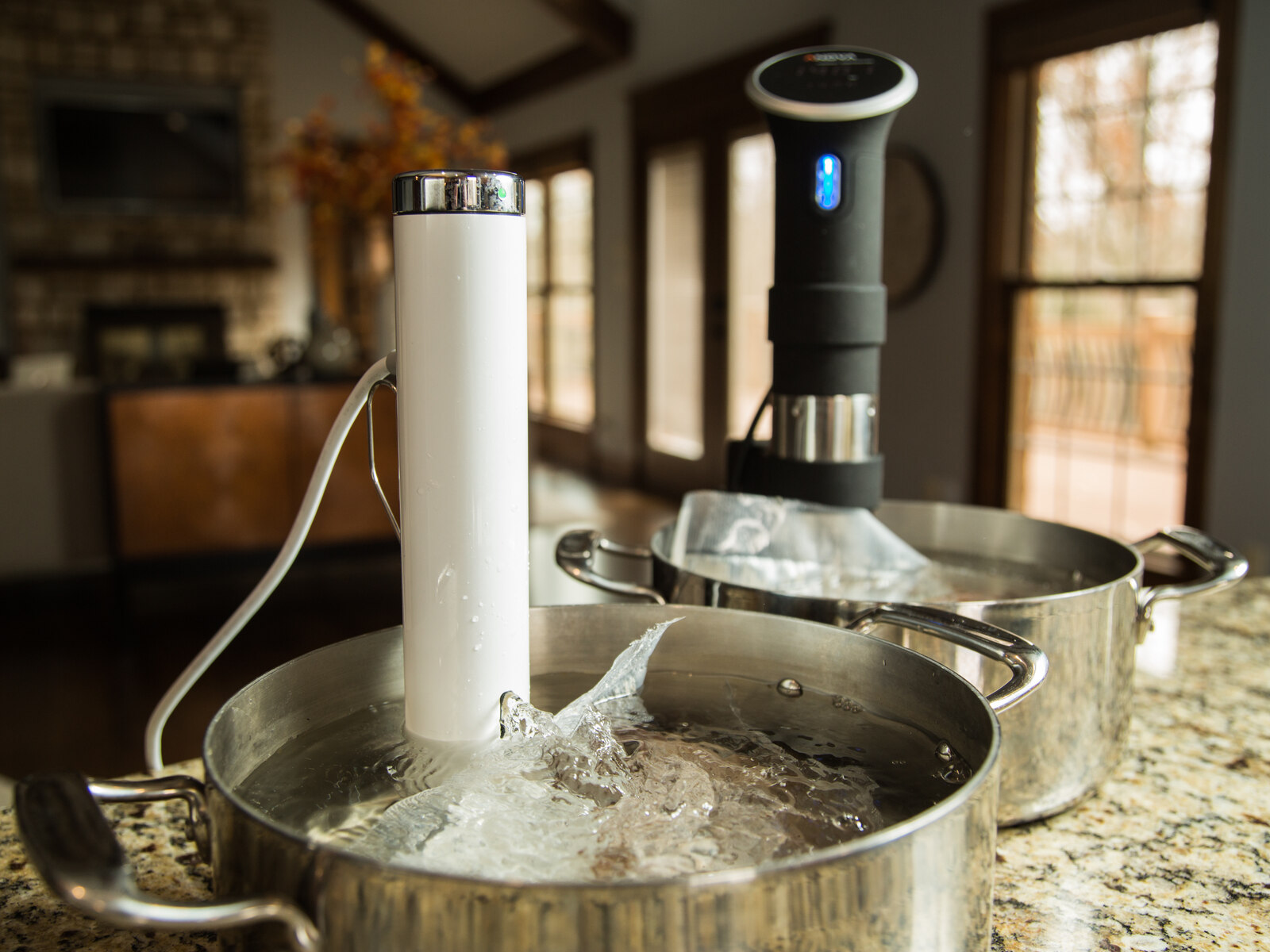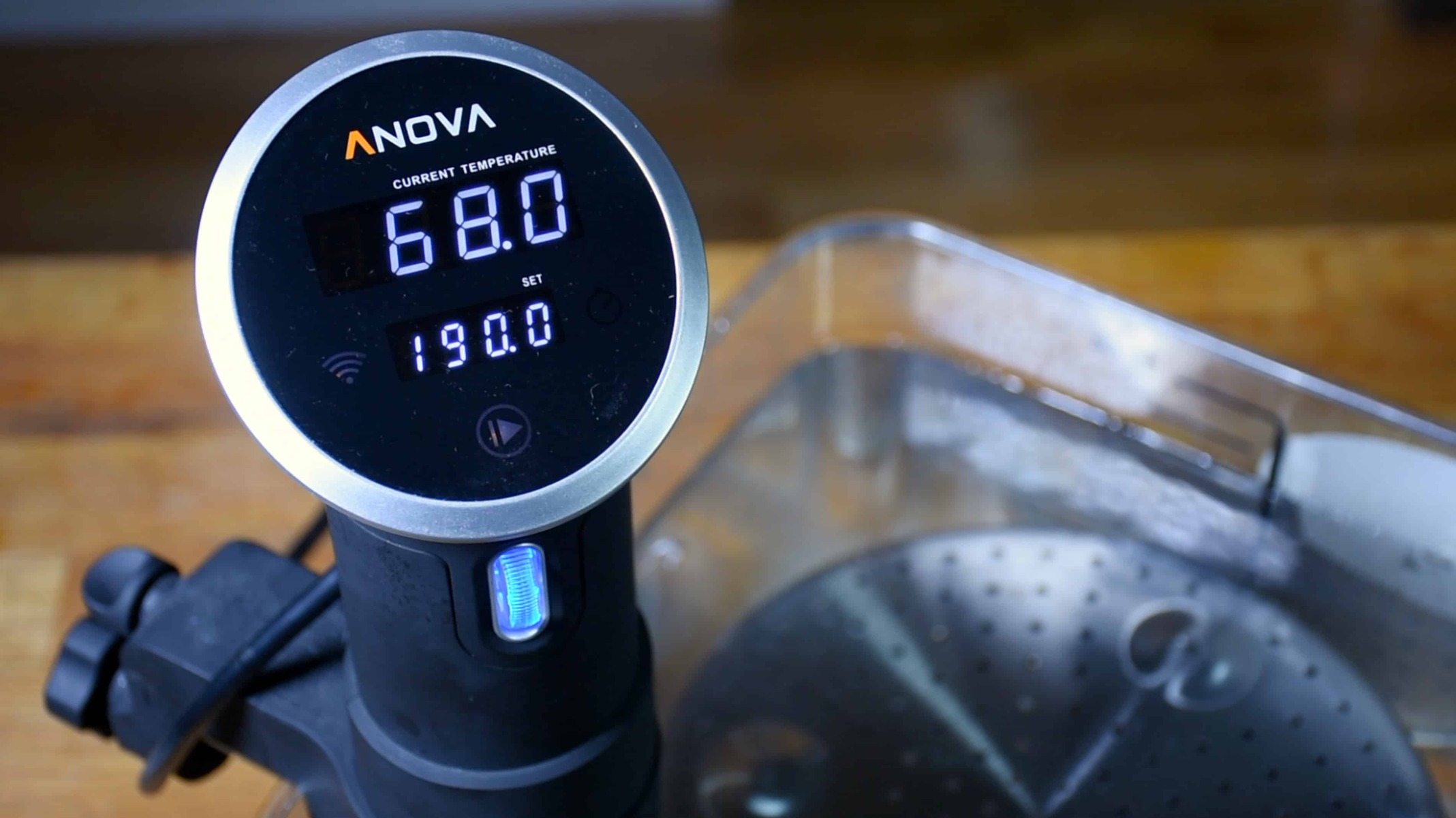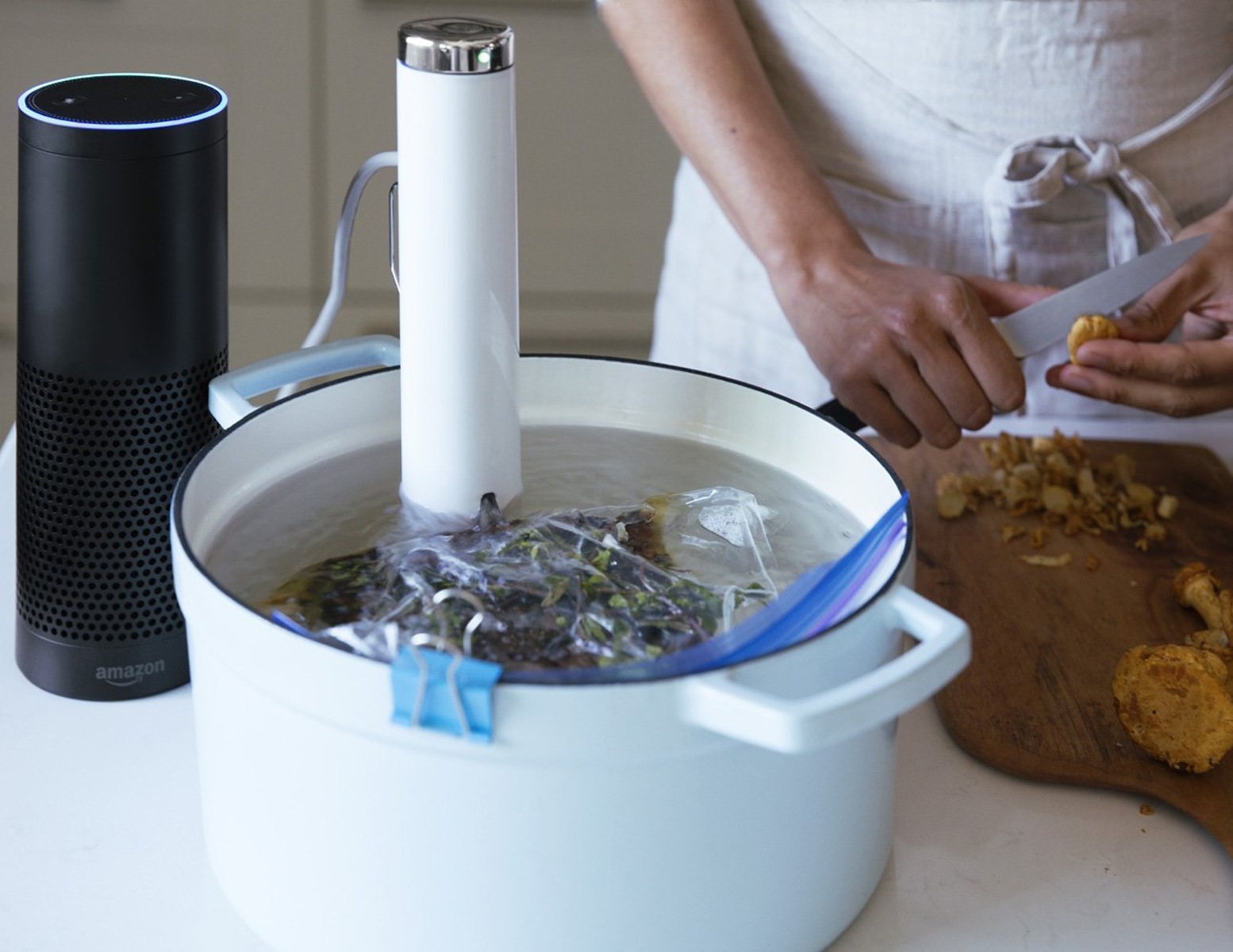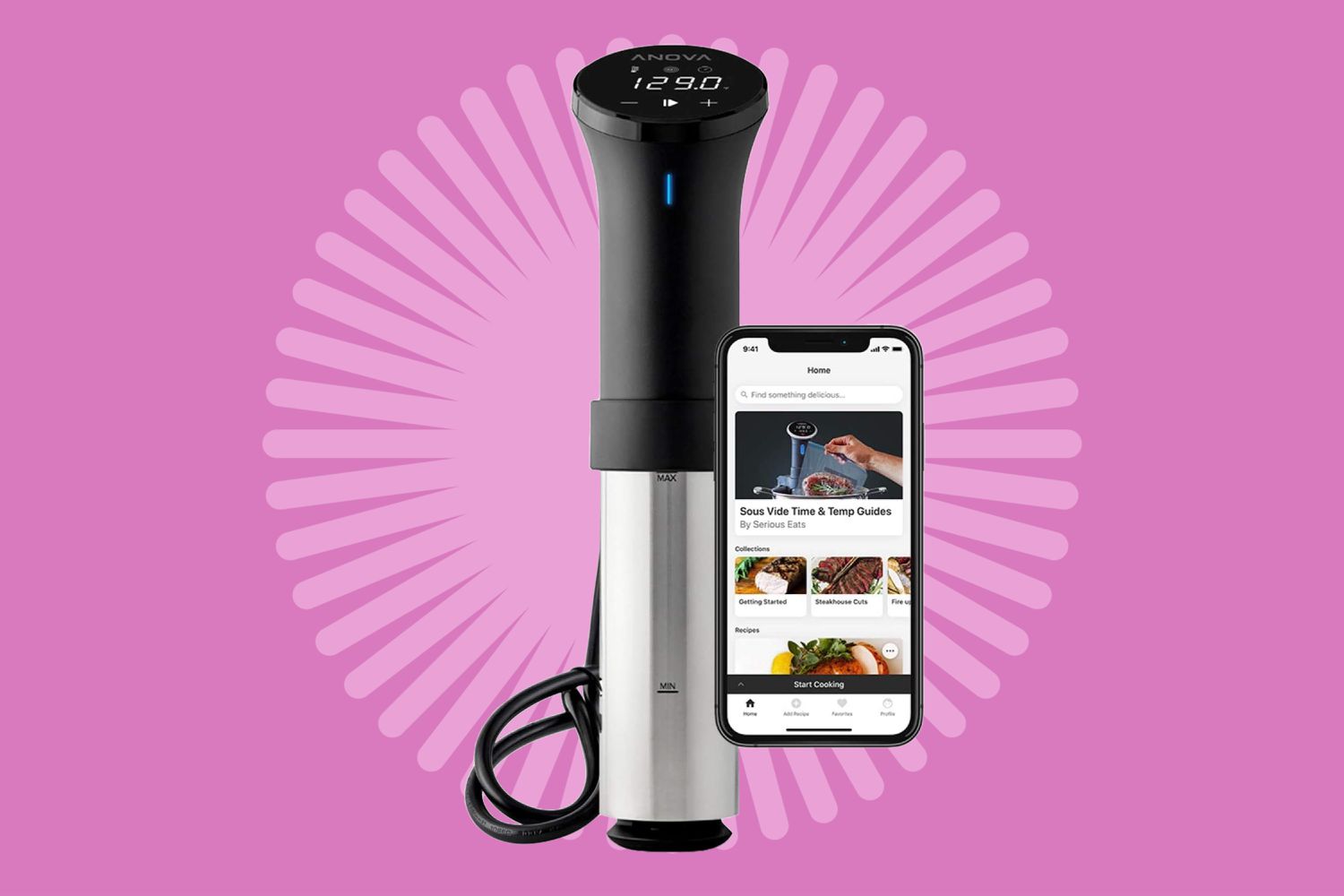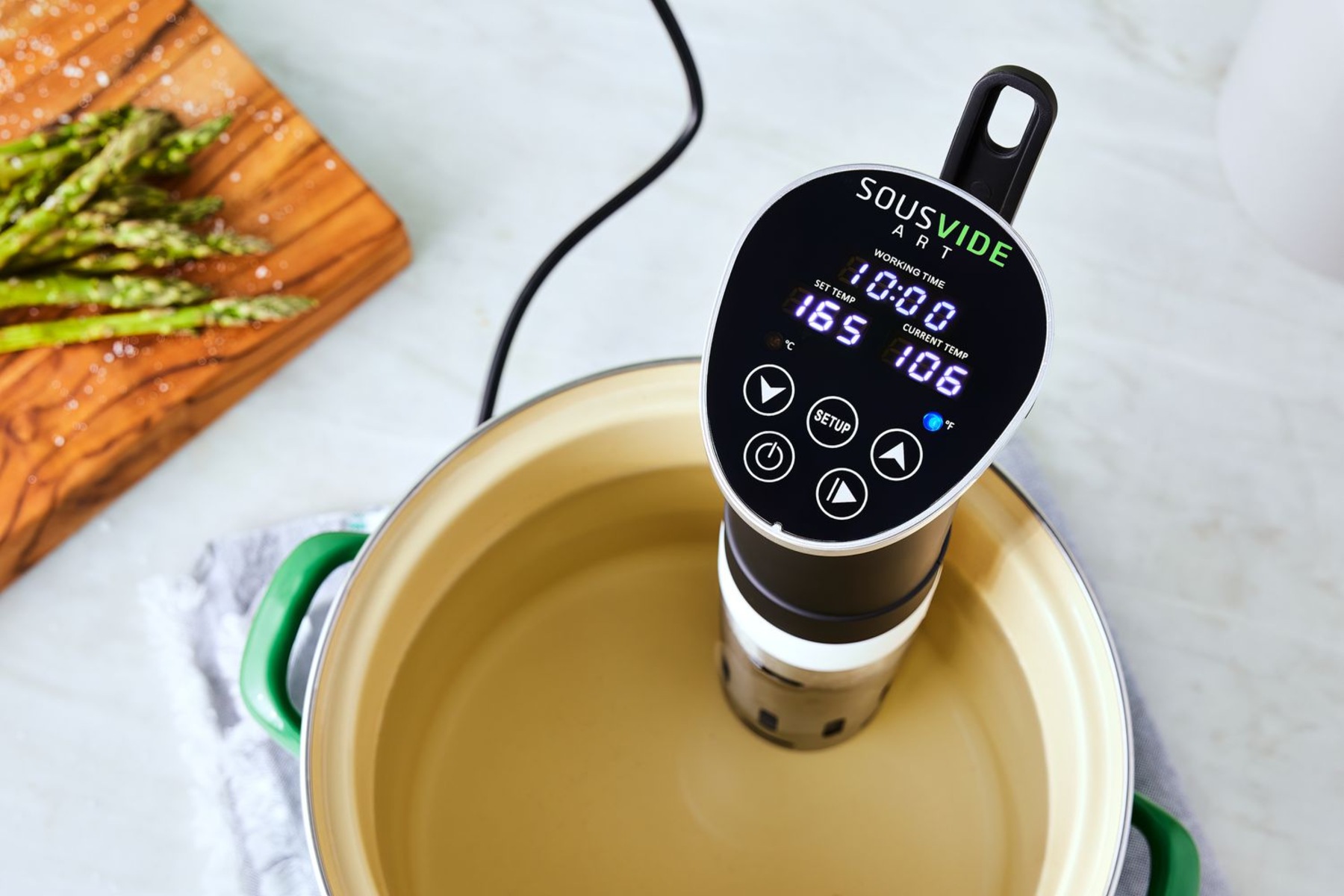Introduction
Welcome to the world of sous vide cooking! If you’re looking to take your culinary skills to the next level, a sous vide machine is a must-have tool in your kitchen. This innovative cooking technique has gained popularity among professional chefs and home cooks alike, thanks to its ability to deliver delicious, perfectly cooked meals.
Sous vide, which means “under vacuum” in French, involves cooking food in a sealed bag at a precise temperature in a water bath. This method ensures that the food is cooked evenly while retaining its natural flavors and juices. Whether you’re a beginner or an experienced cook, using a sous vide machine can elevate your cooking to new heights.
In this article, we will explore the world of sous vide cooking and guide you on how to use a sous vide machine effectively. We’ll cover everything from understanding the benefits of sous vide cooking to choosing the right machine for your needs. So, let’s dive in and discover the secrets of this remarkable cooking technique.
By the end of this article, you’ll have a clear understanding of what a sous vide machine is, how it works, and why it’s worth incorporating into your culinary repertoire. Whether you enjoy cooking for yourself, your family, or entertaining guests, mastering the art of sous vide will open up a whole new world of flavors and possibilities in your kitchen.
So, let’s get started and unlock the extraordinary potential of sous vide cooking!
What is a Sous Vide Machine?
A sous vide machine, also known as an immersion circulator, is a device that allows you to precisely control the temperature of a water bath for sous vide cooking. It consists of a heating element and a circulation pump, which work together to maintain a constant and accurate temperature throughout the cooking process.
Unlike traditional cooking methods, where you rely on guesswork and experience to determine the doneness of your food, a sous vide machine takes the guesswork out of the equation. With its precise temperature control, you can achieve consistent results every time you cook.
The sous vide machine works by heating the water to your desired temperature, typically between 120°F (49°C) and 160°F (71°C), and then circulating the water around the food. This ensures that the food cooks evenly from all sides, resulting in a tender and juicy texture.
One of the key components of a sous vide machine is the ability to use vacuum-sealed bags for cooking. These bags provide an airtight seal, preventing any air or moisture from entering or escaping. This helps to preserve the flavors and juices of the food, resulting in incredibly tasty and succulent dishes.
Modern sous vide machines often come with additional features such as Bluetooth or Wi-Fi connectivity, allowing you to control and monitor the cooking process using a smartphone app. This convenience allows you to start cooking remotely, monitor the progress, and even receive notifications when the food is ready.
Sous vide machines are available in a range of sizes and styles, from compact immersion circulators to countertop water ovens. The right choice for you will depend on your cooking needs and available kitchen space. Regardless of the specific model, using a sous vide machine is a game-changer in terms of precision cooking and culinary creativity.
Now that we have a basic understanding of what a sous vide machine is, let’s explore the numerous benefits of using this revolutionary cooking tool.
Benefits of Using a Sous Vide Machine
Using a sous vide machine offers a wide range of benefits that can greatly enhance your cooking experience. Let’s explore some of the key advantages:
Precision Cooking: One of the greatest advantages of sous vide cooking is its precise temperature control. With a sous vide machine, you can set the water bath to the exact temperature needed for your desired level of doneness. This level of precision ensures consistent results every time, allowing you to achieve perfectly cooked food with no risk of overcooking or undercooking.
Enhanced Flavor and Texture: The controlled, low-temperature cooking of sous vide allows food to retain its natural flavors and juices. This results in dishes that are incredibly tender, moist, and flavorful. Whether you’re cooking meats, vegetables, or even desserts, the sous vide method unlocks the true potential of your ingredients.
Consistency and Repeatable Results: With sous vide, once you’ve discovered the perfect cooking time and temperature for a particular dish, you can easily replicate it with consistent results. This is especially helpful for special occasions or when catering to a large number of guests. You can confidently serve up delicious meals time and time again.
Time and Effort Saving: Sous vide cooking is surprisingly hands-off. Once you’ve prepared your food and set the temperature, you can simply walk away and let the machine do the work. There’s no need for constant monitoring or stirring. This frees up your time to focus on other aspects of your meal preparation or simply relax.
Batch Cooking and Meal Prep: Sous vide is an excellent method for batch cooking and meal prep. You can cook large quantities of food at once and store them for later use. When you’re ready to serve or reheat, a quick sear or finish in a hot pan is all that’s needed to bring the dish back to perfection.
Versatility in Cooking: Sous vide is a versatile cooking method that can be used for various types of food. From proteins like steak, chicken, and fish to vegetables, eggs, and even desserts, the sous vide machine allows you to explore a wide range of culinary possibilities.
Reduced Food Waste: The precise temperature control of sous vide cooking helps to eliminate the risk of overcooking and drying out your food. This means less food waste and more enjoyment from every ingredient.
Professional-Level Results at Home: By utilizing sous vide cooking techniques, you can achieve professional-level results in the comfort of your own kitchen. The consistent and precise nature of this cooking method is often employed by top chefs to deliver impeccable dishes in high-end restaurants.
These are just a few of the many benefits that come with using a sous vide machine. Now that you know the advantages, let’s understand how to choose the right sous vide machine for your needs.
Choosing the Right Sous Vide Machine for You
When it comes to choosing a sous vide machine, there are a few key factors to consider to ensure you find the right one for your cooking needs. Let’s explore these factors:
Temperature Range and Accuracy: Look for a sous vide machine that offers a wide temperature range, typically between 32°F (0°C) and 212°F (100°C), so you have the flexibility to cook a variety of dishes. Additionally, consider the machine’s temperature accuracy. A higher level of accuracy ensures precise cooking results.
Power and Heating Capacity: Take into account the power and heating capacity of the sous vide machine. A more powerful machine will heat the water bath quickly and maintain a consistent temperature even when cooking larger quantities of food.
Size and Design: Consider the size and design of the sous vide machine. If you have limited kitchen space, a compact immersion circulator might be a better option. Alternatively, a countertop water oven provides a self-contained cooking unit with more capacity but may take up more space.
Controls and User Interface: Ensure that the sous vide machine has a user-friendly interface with easy-to-use controls. Look for a machine with a clear display, intuitive buttons, and precise temperature and time settings for effortless operation.
Noise Level: Some sous vide machines can produce a low humming noise during operation. If noise is a concern for you, look for a machine that is known for its quiet operation.
Connectivity Options: If you value convenience and want to have the ability to control and monitor your sous vide machine remotely, consider models that offer Bluetooth or Wi-Fi connectivity. This allows you to adjust settings and monitor the cooking progress through a smartphone app.
Budget: Determine your budget for a sous vide machine and consider the features and quality that align with it. There are sous vide machines available at various price points, so you can find one that suits your needs and budget.
Customer Reviews and Ratings: Before making your final decision, read customer reviews and ratings to get insights from others who have already used the sous vide machine you are considering. Their experiences can provide valuable information about the machine’s performance, durability, and overall satisfaction.
By considering these factors, you can choose a sous vide machine that meets your requirements and enhances your cooking experience. Once you have your machine, it’s time to gather the essential equipment needed for sous vide cooking. Continue reading to learn more.
Essential Equipment for Sous Vide Cooking
When it comes to sous vide cooking, having the right equipment is essential for achieving the best results. Here are the key items you’ll need:
Sous Vide Machine: Of course, the main equipment you’ll need is a sous vide machine, also known as an immersion circulator or a water oven. This device will heat and circulate the water to maintain a precise temperature throughout the cooking process.
Vacuum Sealer or Ziplock Bags: To properly cook your food using the sous vide method, you’ll need a way to securely seal it. A vacuum sealer is a popular option, as it removes all air from the bag, creating an airtight seal. However, if you don’t have a vacuum sealer, you can use resealable plastic bags like Ziplock bags. The key is to remove as much air as possible before sealing them.
Sous Vide-Approved Bags: If you opt for vacuum-sealed bags, it’s important to use bags that are specifically designed for sous vide cooking. These bags are made to withstand the high temperatures and will not melt or leak during the cooking process.
Container or Water Bath: To cook your food sous vide, you’ll need a container or a water bath large enough to hold the desired amount of water and fit the food. Many sous vide machines come with a clamp or clip that allows you to attach them to a pot or container. Alternatively, you can invest in a sous vide container designed specifically for this purpose.
Heat-Resistant Rack or Mat: A heat-resistant rack or mat can be helpful in keeping the food separated and preventing it from sticking to the bottom of the container. This ensures even cooking and prevents any unwanted texture on the surface of your food.
Food Tongs or Slotted Spoon: When handling food in and out of the sous vide bath, it’s important to have a pair of food-grade tongs or a slotted spoon. This will allow you to safely remove the food from the bag or water bath without risking burns or tearing the bag.
Instant-Read Thermometer: While the sous vide machine maintains a precise temperature, it’s still a good idea to have an instant-read thermometer on hand to double-check the doneness of your food after cooking. This ensures that it has reached the desired temperature for safety and taste.
Additional Accessories: Depending on your preferences and cooking style, you may also consider additional accessories such as sous vide weights or clips to prevent food bags from floating, silicone sous vide balls to reduce water evaporation, or a blowtorch for finishing touches like searing or browning.
By having these essential equipment and accessories, you’ll be well-prepared to embark on your sous vide cooking journey. In the next section, we’ll explore the steps involved in preparing your food for sous vide cooking.
Preparing Your Food for Sous Vide Cooking
Properly preparing your food is crucial for successful sous vide cooking. By following a few key steps, you can ensure that your dishes turn out flavorful and perfectly cooked. Here’s how to prepare your food for sous vide cooking:
Seasoning: Start by seasoning your food. This can include marinating meats or adding spices, herbs, and seasonings to enhance flavors. Unlike traditional cooking methods, the sous vide process allows flavors to penetrate the food more intensely, so be mindful of the amount of seasoning you use.
Vacuum Sealing: If you’re using a vacuum sealer, you can place the seasoned food in the bag and remove the air to create an airtight seal. This ensures that flavors are locked in and prevents any liquids or marinades from leaking out during cooking. If using ziplock bags, seal them almost entirely and then immerse them in water, allowing the pressure to force out most of the remaining air before sealing them completely.
Bag Placement: When placing the food in the bag, make sure it’s in a single layer and not overcrowded. This ensures even cooking and allows the water to circulate freely around the food. If you’re cooking multiple items, you can use separate bags or divide them into portion-sized portions to maintain consistency in cooking time and temperature.
Water Displacement: To further remove air from the bag and ensure a tight seal, you can use the water displacement method. Start by sealing the bag except for a small opening. Slowly submerge the bag into the water bath, allowing the water pressure to push out any remaining air. Seal the bag completely once all the air is displaced.
Preheating the Water Bath: Before placing your food in the water bath, ensure that the sous vide machine is preheated to the desired cooking temperature. This allows the water to reach the ideal temperature before cooking, resulting in more precise cooking times for your food.
Protein Pre-searing: For certain proteins like steak or chicken, some cooks prefer to pre-sear the meat before placing it in the sous vide bath. This step can help achieve a more visually appealing sear, but it’s not necessary for the cooking process. If you choose to pre-sear, ensure the meat is cooled before vacuum-sealing or placing it in the water bath.
Cooking Time and Temperatures: Refer to cooking charts or recipes for specific cooking times and temperatures for different types of food. Each protein and ingredient may have different optimal cooking requirements. It’s important to follow guidelines closely to achieve your desired level of doneness and ensure food safety.
Food Safety: Proper food safety measures are crucial when cooking sous vide. Ensure that your food is fresh and handled safely. If cooking meats, make sure they reach the appropriate internal temperature to eliminate any harmful bacteria. It’s recommended to consult food safety guidelines and use a food thermometer to ensure your food is cooked to a safe temperature.
By following these steps, you’ll be well on your way to preparing your food for sous vide cooking. In the next section, we’ll dive into setting up and using your sous vide machine, so you can start cooking with confidence.
Setting Up and Using Your Sous Vide Machine
Setting up and using a sous vide machine is straightforward and requires minimal effort. Here’s a step-by-step guide to help you get started:
Step 1: Familiarize Yourself with the Machine: Read the instruction manual provided by the manufacturer to understand the specific features and functions of your sous vide machine. Familiarize yourself with the control panel, buttons, and settings.
Step 2: Choose the Right Container: Select a heat-resistant container that is large enough to hold the water bath and your food. Ensure the container is deep enough to accommodate the immersion circulator or the water level required by your sous vide machine.
Step 3: Fill the Water Bath: Fill the container with water, leaving enough space to avoid overflowing when your food is submerged. Take into consideration the displacement caused by immersing your vacuum-sealed bags.
Step 4: Attach the Sous Vide Machine: If using an immersion circulator, attach it securely to the side of the container, ensuring it is fully submerged in water. If you have a countertop water oven, simply place it on a stable surface near an electrical outlet.
Step 5: Set the Desired Temperature and Time: Use the control panel or interface on the machine to set your desired temperature and cooking time. Refer to recipes or cooking charts for specific recommendations based on the type of food you’re cooking.
Step 6: Preheat the Water Bath: Allow the sous vide machine to preheat the water bath to your desired cooking temperature. This ensures that the water reaches the correct temperature before adding your food.
Step 7: Place Sealed Bags in the Water Bath: Gently place your vacuum-sealed or Ziplock bags containing the seasoned food into the preheated water bath. Make sure the bags are completely submerged, avoiding any contact with the heating element or any part of the machine.
Step 8: Monitor the Cooking Process: Keep an eye on the cooking process throughout the cooking time. Make any necessary adjustments if the temperature fluctuates or if the water level decreases due to evaporation.
Step 9: Complete the Cooking Time: Once the cooking time is complete, carefully remove the bags from the water bath, using food-grade tongs or a slotted spoon. Be cautious as the bags and food may be hot.
Step 10: Finish the Food (Optional): At this point, you can choose to serve the food as is or finish it with additional cooking methods such as searing in a hot pan, grilling, or broiling to develop a crust or enhance the appearance.
Step 11: Serve and Enjoy: Remove the food from the bags, plate it, and serve immediately while it’s still hot. Pair your sous vide creations with your favorite sides or sauces to complete the dish.
By following these steps, you’ll be able to set up and use your sous vide machine with ease. In the next section, we’ll dive into important considerations for ensuring food safety while cooking sous vide.
Ensuring Food Safety with Sous Vide Cooking
While sous vide cooking offers many benefits, it’s crucial to prioritize food safety to prevent any potential risks. Here are some important considerations to ensure food safety when cooking sous vide:
Safe Temperature: It’s essential to cook your food at a safe temperature to kill any harmful bacteria. Different types of food have specific temperature recommendations. For example, poultry should reach an internal temperature of at least 165°F (74°C) to ensure it is cooked thoroughly.
Proper Vacuum-Sealing: If using a vacuum sealer, ensure proper sealing to prevent any leaks or contamination during the cooking process. Inspect the bags for any signs of damage or leaks before immersing them in the water bath.
Sufficient Cooking Time: Follow recommended cooking time guidelines to ensure that the food is cooked thoroughly. Cooking times may vary depending on the type of food and its size. It’s important to allow enough time for the heat to penetrate and sufficiently cook the food.
Rapid Chilling: After cooking sous vide, it’s crucial to rapidly cool down the food to prevent bacterial growth. Plunge the cooked food into an ice bath to cool it down quickly before transferring it to the refrigerator. Properly cooled food can then be stored in the refrigerator until ready to serve or for later reheating.
Storage and Shelf Life: Store cooked sous vide food properly to maintain its safety and quality. Keep it in airtight containers or resealable bags in the refrigerator, and consume it within a reasonable timeframe. While sous vide cooking can extend the shelf life of certain foods, it’s still important to follow general guidelines for food storage and discard any food that appears spoiled or has been stored for an extended period.
Cross-Contamination Prevention: To prevent cross-contamination, it’s important to keep raw and cooked foods separate. Use separate cutting boards, utensils, and storage containers for different ingredients. Avoid reusing bags that have contained raw meats or seafood without thoroughly cleaning and disinfecting them first.
Quality Ingredients: Start with fresh, high-quality ingredients when cooking sous vide. Ensure that the meat, seafood, or produce you use is fresh, properly stored, and within its recommended shelf life. Using fresh ingredients reduces the risk of bacterial contamination and ensures better overall food safety.
Food Thermometer: To confirm the doneness and safety of your food, use a reliable food thermometer to measure the internal temperature. Insert the thermometer into the thickest part of the cooked food to ensure it has reached the recommended temperature for that specific food type.
Proper Cleanliness: Maintain a clean and sanitized cooking environment. Clean and sanitize your sous vide machine, containers, utensils, and work surfaces before and after each use. Follow proper food hygiene practices, including regular hand washing, to minimize the risk of bacterial contamination.
By following these food safety guidelines, you can enjoy the benefits of sous vide cooking while ensuring the safety of your meals. In the next section, we’ll explore some cooking techniques and tips to help you achieve optimal results with sous vide.
Cooking Techniques and Tips for Sous Vide
While sous vide cooking is known for its precise and consistent results, there are some cooking techniques and tips that can help you take your sous vide dishes to the next level. Here are some techniques and tips to consider:
Pre-searing or Post-searing: To enhance the flavor and texture of certain proteins, you can choose to pre-sear or post-sear them. Pre-searing involves quickly searing the meat in a hot pan before placing it in the sous vide water bath. Post-searing is done after the cooking process to develop a crust or achieve a more visually appealing appearance.
Time and Temperature Experimentation: Sous vide cooking allows for precise control over time and temperature, giving you the opportunity to experiment with different combinations. Adjusting the time and temperature can yield different textures and doneness levels to customize your dishes according to personal preferences.
Adding Aromatics and Flavors: Infuse additional flavors into your sous vide dishes by adding aromatics and seasonings directly into the vacuum-sealed bags. Fresh herbs, garlic, spices, citrus zest, and even butter can all add depth and complexity to your dishes.
Brining and Marinading: Brining or marinating your proteins before sous vide cooking can further enhance their juiciness and flavor. The airtight seal of the vacuum-sealed bags ensures that the flavors penetrate the meat, resulting in a more delicious end product.
Using Sous Vide Weights: Prevent bag float and ensure even cooking by using sous vide weights. These can be food-safe weights or even stainless steel or ceramic objects, placed on top of the bag to keep it submerged in the water bath.
Utilizing Sous Vide Racks: Sous vide racks or baskets can be helpful when cooking multiple bags of food at once. These racks keep bags separate and organized, preventing them from touching each other during cooking and ensuring even circulation of water around each bag.
Patting Dry before Searing: When removing food from the sealed bags, make sure to pat it dry with a paper towel before searing or finishing in a hot pan. This helps to remove excess moisture, allowing for a better sear and a more attractive presentation.
Sous Vide for Meal Prep: Utilize the convenience of sous vide cooking for meal prep. Cook larger batches of proteins or vegetables and store them in the refrigerator or freezer. You can reheat or finish them quickly for easy and delicious meals throughout the week.
Experimenting with Sous Vide Desserts: Sous vide cooking is not limited to savory dishes. Explore the world of sous vide desserts, such as custards, cheesecakes, or poached fruits. The precise temperature control can help you achieve perfectly cooked and creamy desserts.
Thoroughly Chill Cooked Food: After cooking sous vide, ensure that the food is rapidly chilled in an ice bath before refrigerating or freezing. This helps maintain food safety and quality by preventing the growth of bacteria.
By applying these techniques and tips, you can elevate your sous vide dishes and unlock even more culinary possibilities. In the next section, we’ll explore ways to add additional flavor to your sous vide cooked food.
Adding Flavor to Sous Vide Cooked Food
One of the unique aspects of sous vide cooking is the ability to enhance flavors in exciting ways. While sous vide cooking naturally preserves and intensifies the flavors of ingredients, there are additional methods to add even more depth and complexity to your sous vide cooked food. Here are some techniques for adding flavor to your sous vide dishes:
Aromatics and Herbs: Infusing your sous vide dishes with aromatic ingredients can elevate their flavor profiles. Fresh herbs like rosemary, thyme, basil, or sage, as well as aromatic spices like cinnamon sticks, star anise, or cardamom pods, can add a tantalizing aroma and taste to your food.
Citrus Zest: The zest of citrus fruits, such as lemon, lime, or orange, can provide a burst of bright, refreshing flavor. Add a sprinkle of zest over your sous vide cooked fish, poultry, or vegetables just before serving to awaken the taste buds.
Marinades and Sauces: Before or after sous vide cooking, you can marinate your proteins with flavorful ingredients like soy sauce, balsamic vinegar, garlic, or honey. Alternatively, you can prepare a tasty sauce or glaze to drizzle over your sous vide cooked food, enhancing its flavor and adding a delicious finishing touch.
Butter Basting: For meats, butter basting can add richness and depth. Just before or after the sous vide cooking process, sear the meat in a hot pan with a knob of butter, continuously spooning the melted butter over the meat. This technique helps to create a luscious, flavorful crust.
Smoking or Grilling: To introduce a smoky flavor, you can finish your sous vide cooked proteins on a grill or use a smoking technique. This adds complexity and a hint of smokiness to your food, giving it that irresistible charred flavor.
Caramelization: Searing your sous vide cooked proteins in a hot pan can create a beautiful caramelized crust. This Maillard reaction adds depth of flavor and a delightful textural contrast to your dishes.
Enhancing Natural Juices: After sous vide cooking, you can collect the flavorful juices that accumulate in the vacuum-sealed bags. These concentrated juices can be used to create a sauce or reduction, intensifying the flavors even further.
Infusing Oils and Liquids: Infusing oils or liquids can impart unique flavors to your sous vide dishes. You can infuse oils with herbs, spices, or even garlic by gently heating them together. Alternatively, you can infuse liquids like broth, wine, or stocks to add another layer of taste.
Using Flavored Salt or Rubs: Season your proteins with flavored salts, rubs, or spice blends before vacuum-sealing. This enhances the flavor from within, allowing the meat to absorb the seasonings during the sous vide cooking process.
Experimenting with Ingredients: Don’t be afraid to experiment with different ingredients to discover new flavor combinations. Consider incorporating ingredients like truffle oil, miso paste, chili flakes, or even infused spirits to create unique and exciting flavor profiles.
By utilizing these flavor-enhancing techniques, you can take your sous vide dishes to new heights of deliciousness. In the next section, we’ll explore some mouthwatering recipes to inspire your sous vide cooking adventures.
Recipes for Sous Vide Cooking
Ready to put your sous vide machine to use? Here are a few mouthwatering recipes that you can try for your sous vide cooking adventures:
1. Sous Vide Steak: Achieve the perfect medium-rare steak every time. Season a high-quality steak with salt, pepper, and any desired herbs or spices. Vacuum-seal the steak and cook it in the sous vide water bath at 130°F (54°C) for 1.5 to 2 hours. After cooking, pat it dry and sear it in a hot pan or on a grill to develop a nice crust. Serve with your favorite side dishes.
2. Sous Vide Salmon: Create tender and flaky salmon with a delicate flavor. Season the salmon fillets with salt, pepper, and lemon slices. Vacuum-seal and cook in the sous vide water bath at 125°F (52°C) for 45 minutes to 1 hour. Finish by searing the skin side in a hot pan for a crispy texture. Serve with a refreshing dill sauce and roasted vegetables.
3. Sous Vide Chicken Breast: Ensure juicy, flavorful chicken breasts every time. Season the chicken breasts with salt, pepper, and herbs of choice like thyme or rosemary. Vacuum-seal and cook in the sous vide water bath at 145°F (63°C) for 1 to 2 hours. Finish by briefly searing them in a hot pan for a golden-brown exterior. Serve with a side of roasted potatoes and a fresh salad.
4. Sous Vide Pork Tenderloin: Enjoy succulent and perfectly cooked pork tenderloin. Season the tenderloin with a spice rub, vacuum-seal it, and cook in the sous vide water bath at 140°F (60°C) for 2 to 3 hours. Finish by searing in a hot pan with a touch of olive oil for a caramelized crust. Serve with a side of roasted vegetables and a tangy apple chutney.
5. Sous Vide Crème Brûlée: Create a velvety smooth and creamy dessert. In a mixing bowl, whisk together egg yolks, sugar, vanilla extract, and heavy cream. Transfer the mixture to small mason jars or ramekins and seal them with lids or plastic wrap. Cook in the sous vide water bath at 176°F (80°C) for 1 to 1.5 hours. Once chilled, sprinkle sugar on top and use a kitchen torch to caramelize the sugar until it forms a crispy crust.
6. Sous Vide Vegetables: Preserve the vibrant colors and flavors of seasonal vegetables. Season the vegetables with olive oil, salt, pepper, and any desired herbs or spices. Vacuum-seal the vegetables and cook in the sous vide water bath at 185°F (85°C) for 20 to 30 minutes, depending on the desired tenderness. Finish by quickly sautéing them in a hot pan with a knob of butter for a touch of richness.
These recipes provide a starting point, but feel free to modify them according to your taste preferences. Experiment with different seasonings, sauces, and side dishes to create your own personalized sous vide masterpieces.
Now that you have some delicious recipes to try, let’s move on to the topic of cleaning and maintaining your sous vide machine.
Cleaning and Maintaining Your Sous Vide Machine
Proper cleaning and maintenance of your sous vide machine are essential for its longevity and optimal performance. Here are some guidelines to help you keep your machine in top shape:
Cleaning After Each Use: After each use, disconnect the sous vide machine from the power source and allow it to cool down. Remove any remaining water from the water bath and discard it. Wipe down the machine’s exterior with a damp cloth to remove any food residue or spills.
Deep Cleaning: Periodically, perform a deep cleaning of your sous vide machine. Refer to the manufacturer’s instructions for specific guidelines. This may involve dismantling and cleaning the heating element, circulation pump, or any detachable parts. It’s important to follow the manufacturer’s recommendations to ensure you don’t damage the machine.
Water Bath Cleaning: Clean the water bath or container used for sous vide cooking after each use. Dispose of the water and thoroughly clean the container with warm soapy water. Rinse it well to remove any soap residue. Regularly check for any mineral or scale buildup and descale the container if necessary, following the manufacturer’s instructions.
Storage and Drying: Allow all components of the sous vide machine to dry completely before storing them. This helps to prevent any moisture buildup or potential mold growth. Store the machine and its accessories in a clean, dry, and well-ventilated area.
Regular Maintenance: Follow any recommended maintenance procedures specified by the manufacturer. This may include checking for and replacing any worn or damaged parts, such as gaskets or seals. Regularly inspect the cords and plugs for any signs of fraying or damage and have them repaired or replaced if needed.
Safe Storage of Power Cords: When storing your sous vide machine, ensure that the power cords are neatly wrapped and stored away from any sharp objects or areas where they may get tangled or damaged. This helps to maintain their integrity and prevent any electrical hazards.
Update Firmware or Software: If your sous vide machine has firmware or software that can be updated, periodically check for any updates provided by the manufacturer. These updates may include improvements, bug fixes, or new features that can enhance the performance of your machine.
Follow Manufacturer’s Guidelines: Always consult the manufacturer’s guidelines and instructions specific to your sous vide machine. They provide the most accurate and detailed information regarding cleaning, maintenance, and any specific requirements for your machine.
By following these cleaning and maintenance practices, you can ensure the longevity and optimal performance of your sous vide machine. Taking care of your machine will not only help you enjoy many delicious meals but also provide you with a reliable and consistent cooking tool for years to come.
Now that you have learned about cleaning and maintaining your machine, let’s wrap up this article with a quick summary of the key points discussed.
Conclusion
Sous vide cooking is a remarkable technique that allows you to achieve precise and consistent results in your culinary creations. With the help of a sous vide machine, you can elevate your cooking skills and explore new flavors and textures. By understanding the fundamentals of sous vide cooking and following key guidelines, you can make the most out of this incredible cooking method.
We began our journey by introducing the concept of sous vide cooking and its benefits. We then explored the factors to consider when choosing a sous vide machine and the essential equipment needed for this cooking technique. Additionally, we delved into the important steps of preparing food for sous vide cooking, setting up and using the sous vide machine, and ensuring food safety throughout the process.
We discussed various cooking techniques and tips to enhance your sous vide dishes, including adding flavor with aromatics and seasonings, pre-searing or post-searing, and experimenting with different ingredients. We offered a collection of tantalizing recipes to inspire your sous vide cooking adventures, ranging from steaks and seafood to desserts and vegetables.
Furthermore, we highlighted the significance of cleaning and maintaining your sous vide machine. Regular cleaning, deep cleaning when necessary, and safe storage practices help keep your sous vide machine in top shape and ensure its longevity.
With this newfound knowledge, you can confidently embrace the world of sous vide cooking. Explore the culinary possibilities, experiment with flavors, and savor the delectable results that sous vide cooking can provide. So, grab your sous vide machine, gather your ingredients, and embark on a culinary journey that will elevate your cooking skills and impress even the most discerning of palates.







